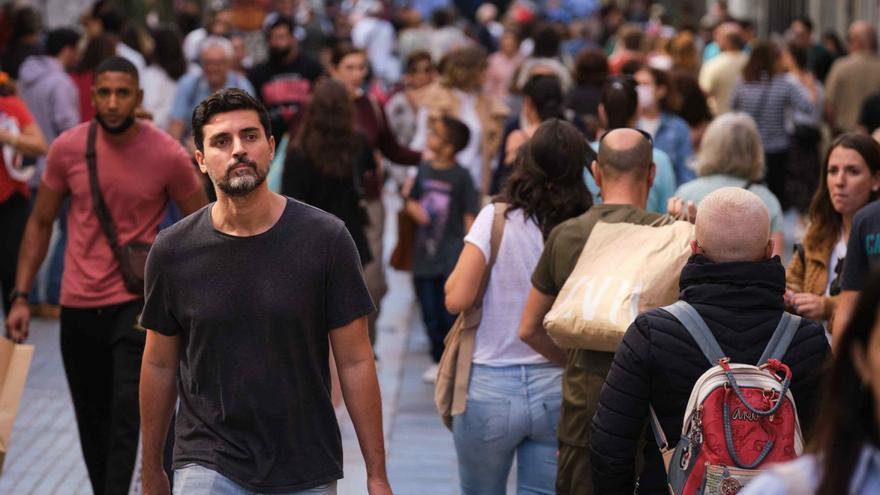
The population of the island of Tenerife It has increased by some 3,000 people since 2020, despite the excess mortality caused by the covid-19 pandemic. However, in the last three years there are 10 Tenerife municipalities that have lost neighbors compared to another 21 that have not stopped growing despite the complicated situation. The population reduction has been primed with the metropolitan area, where Santa Cruz de Tenerife and La Laguna have lost 1,602 inhabitants since 2020; Isla Baja, which once again reduced its census by 120 people, and the towns of Puerto de la Cruz, with 143 fewer; Santiago del Teide, with 119; Guía de Isora, with 85, and San Juan de la Rambla and La Matanza de Acentejo, which lost just 9 and 5 inhabitants, respectively.
Santa Cruz de Tenerife has 208,688 inhabitants, according to the revision of the Municipal Register on January 1, 2022, published by the INE at the end of last year. This figure represents a reduction of 506 residents compared to 2020 (209,194). In San Cristóbal de La Laguna there were 158,911 registered people in 2020, in 2022 there are 1,096 less (157,815). Between the two most populated municipalities on the island they have lost 1,602, a figure similar to that of all the inhabitants of Vilaflor (1,767).
While Granadilla de Abona (+1,214), Adeje (+240) or Arona (+205) have not stopped growing, there are three tourist municipalities that are losing population. These are Guía de Isora, which suffered a decrease of 116 residents between 2021 and 2022; Puerto de la Cruz, which now has 143 fewer residents than in 2020 (despite the increase of 170 between 2021 and 2022), and Santiago del Teide, which has lost 119 residents compared to 2020, although like Puerto de la Cruz it seems to reverse the trend by winning 47 between 2021 and 2022.
The exception of Garachico
Isla Baja, the region formed by Garachico, Los Silos, Buenavista del Norte and El Tanque, has declined again in the last three years, despite the fact that Garachico grew by 51 neighbors between 2020 and 2022. The worst part is borne by Los Silos , with 99 fewer neighbors in this period; followed by El Tanque, with 39 fewer, and Buenavista del Norte, with a drop of 33. This region is evolving in the opposite direction than the island and in 2022 it has less population than in 1960, before the tourism boom. Between 1994 and 2014, these towns in the northwest of Tenerife have already lost 2,814 inhabitants. Only Garachico has managed to stop depopulation, but the rest of the towns on Isla Baja have continued to lose neighbors little by little. The data on the historical evolution of the population of the municipalities of the Archipelago, compiled by the Canary Islands Institute of Statistics (Istac) based on figures from the National Institute of Statistics (INE), show that in 1960 Isla Baja had a total of 18,137 inhabitants, and now there are 17,130, a thousand residents less than 63 years ago.
Cleaned patterns
Depopulation accelerated in this area between 2002 and 2014, mainly due to the purification of some registers that accumulated errors and were inflated. In that adjustment period, the four municipalities lost 2,280 inhabitants. Garachico currently has 4,920, 347 less than in 1960 (5,267), 101 less than in 1950 (5,021) and even 93 less than in 1940 (5,013). In the 1980s and 1990s, it regularly exceeded 6,000 and is now approaching 5,000.
Los Silos broke the barrier of 5,000 inhabitants in 1960 and since then it had never dropped below that figure, until 2014 arrived and its population remained at 4,727 people. Since then, he has failed to stop the bleeding. The current figure, 4,644, leads the municipality to worse data than in 1950, when the town had 4,690 residents. Buenavista del Norte registers 4,753 residents in the last update of the census, 268 fewer than in 1960. This town had more than five thousand residents between 1986 and 2012. And in the 1990s it never dropped below 5,469, 716 more than now . El Tanque is the only municipality that currently has (2,813) more inhabitants than in 1960, but less than in 1970, when it had 2,830. This town reached 3,000 inhabitants in 1991 and maintained it until 2010, when it fell below three thousand for the first time. A barrier that has not been overcome again and that seems to get a little further away every year. The work of the insular ring to Santiago del Teide, which will facilitate a faster connection with the South, is the great hope for the tanker demographic growth.
La Matanza de Acentejo currently has five fewer inhabitants than in 2020, but in the last year, the decrease was 60. In the case of San Juan de la Rambla, its population fell by nine people compared to 2020, despite the fact that between 2021 and 2022 it gained ten more inhabitants. Vilaflor lost 22 inhabitants in the last closed year, but if compared to 2020, it has 52 more neighbors.
The other side of the coin, that of growth, has its best figures between 2020 and 2022 in Granadilla de Abona, with 1,214 new residents; Arico, with 643 more inhabitants; Guimar, with 562; Tacoronte, with 391; Los Realejos, which increased by 349; San Miguel, with 294; El Rosario, with 254; La Orotava, with 247; Adeje, with 240; Arona, with 205; Icod de los Vinos, which grows 180, or Santa Úrsula, with 161 more. Other towns that have grown in this period are Candelaria (+102), Tegueste (+72), El Sauzal (+65), Fasnia (+31), Arafo (+30), La Guancha (+21) or La Victoria ( +12).















